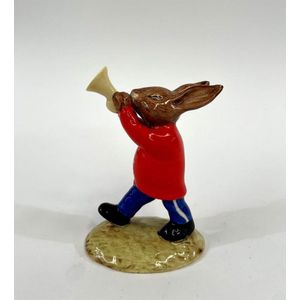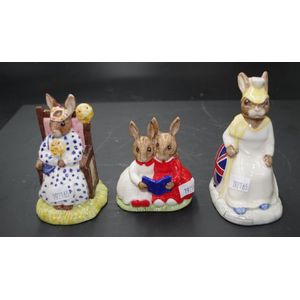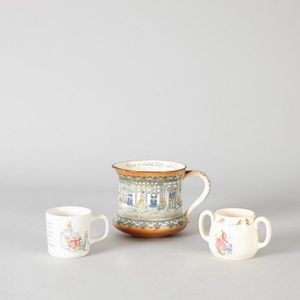
Royal Doulton Bunnykins Scout & Brownies Figurine Set with Certificate
Six Royal Doulton Bunnykins Scout & Brownies be Prepared DB56, Brownie DB61, Scout Leader DB432, boy Scout DB430, girl guide DB431 and guide Leader DB433 (repair to flag wtih certificate)

Royal Doulton Bunnykins Porcelain Collection, Signed Barbara Vernon
Royal Doulton "Bunnykins" porcelain plates, bowls and tea ware, (18 items), some signed "Barbara Vernon", the largest plate 21 cm diameter

Royal Doulton "Bunnykins" Collection: Jugs, Mugs, Money Box, Egg Cup
Royal Doulton "Bunnykins" porcelain jugs, mugs, money box and egg cup, (8 items), some signed "Barbara Vernon", the largest jug 12 cm high

Royal Doulton Bunnykins Teacups and Saucers Set by Barbara Vernon
Royal Doulton "Bunnykins" group of twelve teacups and saucers, some signed "Barbara Vernon", the saucers 14 cm diameter

Royal Doulton Sporting Bunnykins Collection with Original Certificates
Five Royal Doulton Sporting Bunnykins DB447 Don't Let go, DB445 Caught A whopper, DB427 On the Fairway, DB445 Slap shot and DB446 Home Run Hero Baseball player repair to bat, from Past Times collection, most with original certificates

Royal Doulton Dancing Bunnykins Special Event Collection Certificate of Authenticity
Four Royal Doulton 'Dancing' Bunnykins all Special Event Bunnykins: DB204 Morris Dancer, DB242 Tyrolean Dancer, DB256 Flamenco and DB261 Hornpiper certificate for Hornpiper 100 200

Signed Bunnykins Series Ware by Barbara Vernon (5 pieces)
Royal Doulton 'Bunnykins' series ware, (5 pieces or which 4 are signed by Barbara Vernon), comprising of a mug, a small bowl, a small plate and 2 saucers.

Pair of Bunnykins Children's Mugs by Royal Doulton
Two Royal Doulton, England porcelain 'Bunnykins' Childrens' mugs, height 8 cm

Royal Doulton Bunnykins Trumpeter Figure - 11cm
A Royal Doulton Trumpeter Bunnykins figure DB24, height 11 cm

Royal Doulton Bunnykins School Master Figure - 12cm
A Royal Doulton school master Bunnykins figure DB60, height 12 cm

Royal Doulton Mystic Bunnykins Figure - 13cm
A Royal Doulton Mystic Bunnykins figure DB179, height 13 cm

Royal Doulton Gardener Bunnykins Figure - 12 cm
A Royal Doulton Gardener Bunnykins figure DB156, height 12 cm

Royal Doulton Limited Edition Bunnykins Pair
Two limited edition Royal Doulton bunnykins old King Cole DB458 limited edition 264/500 and Britannia Bunnykins DB219 limited edition for international UK ceramics, both with box and certificate\, made in England

Royal Doulton Bunnykins Teapots: World Editions (1994-1996)
Three Royal Doulton Bunnykins teapots of the world 'London city Gent', circa 1994, 'U.S.A. President', circa 1995, 'Aussie Explorer', circa 1996, all special edition of 2,500, all approx. 21 cm high

Cabin Boy Bunnykins Figure from Royal Doulton Collection
Royal Doulton 'Cabin Boy Bunnykins' figure DB324, from 'The Shipmates' Collection, with certificate, height 12 cm

Limited Edition Bunnykins Fortune Teller Jug
Royal Doulton 'Fortune Teller Bunnykins' jug D7157, limited edition ceramic jug, # 515/1,500, height 14 cm

Royal Doulton Bunnykins Figurines Set
Three various Royal Doulton bunnykins figurines comprising Britannia bunnykins DB219 with certificate and box, Susan as Queen of the May DB83 with box, and partners in collecting DB151 with box, height 11 cm tallest

Collection of Five Royal Doulton Bunnykins Figurines with Boxes
Five various Royal Doulton bunnykins figurines comprising Postman DB76, schoolmaster DB60, with love DB269, Billie DB3, and Prince Frederick DB48, height 11 cm tallest, four boxes included

Bunnykins Bookends
Two Royal Doulton Bunnykins bookends comprising summer dreams and story time, height 13.5 cm

Collection of Six Royal Doulton Bunnykins Figurines
Six various Royal Doulton Bunnykins figurines comprising Clarissa the clown DB331, Tourist DB 190, Girl guide DB431, Ankhesenamun DB295, Sightseer DB215, Judy DB235, height 11 cm

Christmas Bunnykins Collection with Rare Colorway
Four Royal Doulton Christmas Bunnykins including 'Stocking Filler' and 'Christmas Surprise', including a rare colourway

Limited Edition Digger Bunnykins Figure with Certificate and Box
Royal Doulton 'Digger' Bunnykins figure limited edition, with certificate and box

Vintage Royal Doulton Bunnykins Figurines Collection
Four vintage Royal Doulton Bunnykins including Mrs Bunnykins 'Clean Sweep' DB6, Mr Bunnykins 'Autumn Days' DB5, Buntie Bunnykins 'Helping Mother' DB2 and Little Jack Horner DB221

Royal Doulton Bunnykins Music Collection
Three Royal Doulton music themed Bunnykins 'Banjo Player' DB182 with certificate and 'Saxophone Player' DB186, both limited editions from The Jazz Band collection, and Mr Bunnybeat 'Strumming' DB16

Royal Doulton Bunnykins Master Potter Figure
A Royal Doulton Bunnykins master potter figure DB131, 9.50 cm.

Bunnykins Collection with Limited Edition Pieces
Royal Doulton Bunnykins and stand including Minstrel Bunnykins DB211 limited edition, Jester DB161, Town Crier DB259 limited edition, Romeo DB284, and Juliet DB283

Royal Doulton Bunnykins Figurine Collection with Boxes
Five various Royal Doulton Bunnykins figurines including the artist DB13, Judy Bunnykins DB235 & Mr Punch DB234 limited edition from the Punch & Judy series, Freefall DB41, and Billy Bunnykins cooling off DB3, height 12 cm tallest, all with boxes

Royal Doulton Bunnykins Henry VIII and 6 Wives Figurines
Royal Doulton Bunnykins Henry VIII Tudor group limited edition series, comprising Henry VIII height 11 cm, with figures of each of his 6 wives, all included on a stepped stand loss of paint to back of Katherine Howard figure

Royal Doulton Bunnykins Figures with Original Packaging
Four Royal Doulton 'Bunnykins' figures including: Daisy, Goodnight, Busy Needles, and Sweet Dream baby bunny, each with original packaging, height 8 cm, average each.

Royal Doulton Bunnykins Sports Figures with Packages
Five Royal Doulton 'Bunnykins' sporting figures including: Ace tennis player, Downhill skier, Jogging, Aerobics, and Knockout boxing, with 2 original packages, height 11 cm, average each.

Limited Edition Bunnykins Robin Hood Figures with Stand
Royal Doulton Bunnykins Robin hood series with eight figures and stand, made in England, limited edition series, width 35 cm stand

Royal Doulton and Wedgwood Bunnykins and Peter Rabbit Mugs
A Royal Doulton 'Old Moreton Hall' jug, also includes a Royal Doulton Bunnykins baby mug and and Wedgwood Peter Rabbit mug, height 13 cm, width 11 cm, depth 18 cm

Limited Edition Royal Doulton Bunnykins Figure with Certificate
Royal Doulton 'Federation Bunnykins' figure DB224, Limited edition, # 1921/2500, height 12 cm with Certificate.

First Bunnykins Figurine - 75th Anniversary Edition
Royal Doulton My First Bunnykins figurine HN5369, Hand made and hand decorated Celebrating 75 years of Bunnykins By Royal Doulton, with original box and certificate

Royal Doulton Bunnykins Dish Set
Royal Doulton Bunnykins dish, plate and two bowls, 20th century, (4 items), pictorial Bunnykins backstamps, two pieces signed Barbara Vernon, the plate 22 cm diameter

Australian Bunnykins Bicentennial Figure by Royal Doulton
Royal Doulton Australian Bunnykins figure Bicentennial DB58, made in England

Limited Edition Bunnykins 'Aussie Ute' Tableau with Packaging
Royal Doulton Bunnykins 'Aussie Ute' tableau DB492, limited edition, # 206/400, length 18 cm, including original packaging.

Royal Doulton Bunnykins Huntsman Figure with Certificate
Royal Doulton Bunnykins 'Huntsman' figure marked to base, height 14 cm, including certificate for Bunnykins of the year, 2009.

Royal Doulton Bunnykins Figurines Set
Five Royal Doulton Bunnykins figurines including Sundial, Vicar, fortune teller, rainy day, and Mrs Bunnykins restored, all in original boxes

Royal Doulton Bunnykins Shipmates Figurine Collection
Six Royal Doulton Bunnykins figurines from the ships mates collection, including Ship's cook, Captain's wife, Seaman, Boatswain, Captain, and Pirate

Bunnykins Figurine Collection with Chip on Susan's Ear
Five Royal Doulton Bunnykins figurines including sleepy time, jogging bunnykins, sailor bunnykins, Billie & Buntie bunnykins, Susan bunnykins chip to ear

Royal Doulton Bunnykins Figurines with Restored Ears and Boxes
Five Royal Doulton Bunnykins figurines including Morris Dancer, Fisherman, Sands of time, boy skater, and Family photograph restored to ears, four in original boxes

Limited Edition Royal Doulton Digger Bunnykins Figure
Royal Doulton Digger bunnykins figure Ltd edition- made in England

Royal Doulton Bunnykins Figurines Set
Four Royal Doulton Bunnykins figurines including Ankhesenamun, Gardiner, school days, and school master, all in original boxes

Royal Doulton Bunnykins Tudor Group with Henry VIII and Wives
Royal Doulton Bunnykins Henry VIII Tudor group comprising Henry VIII, height 11 cm, with figures of each of his 6 wives, all included on a stepped stand.

Royal Doulton Bunnykins Children's Set with Barbara Vernon
Eight Royal Doulton Bunnykins Children's items including Barbara Vernon, comprising 4 plates, breakfast bowl, 2 mugs, and an egg cup

Limited Edition Royal Doulton Bunnykins Figurine with Certificates
Royal Doulton Federation bunnykins figurine Ltd edition with box and certificates - made in England

Royal Doulton Bunnykins Henry VIII and 6 Wives Set
Royal Doulton Bunnykins Henry VIII Tudor group comprising Henry VIII, height 11 cm, with figures of each of his 6 wives, all included on a stepped stand. Some original packaging available.

Limited Edition Royal Doulton Bunnykins Figurine with Box & Certificates
Royal Doulton Digger bunnykins figurine Ltd edition with box and certificates - made in England

Royal Doulton Baby Serving Set
Three Royal Doulton baby serving items comprising a Bunnykins bowl and cup both signed Barbara Vernon, and a Old Mother Hubbarb and dog bowl

Royal Doulton Bunnykins Dish and Bowls Set with Chip
A Royal Doulton Bunnykins dish, two bowls and an egg cup, chip to egg cup

Royal Doulton Bunnykins Plates - Set of Three
Three Royal Doulton Bunnykins plates, diameter 14.5 - 20.5 cm

Royal Doulton Bunnykins Set of 5 Items
Five Royal Doulton Bunnykins items, including cup, saucer and plate, mug and double handle mug [5]

Royal Doulton Bunnykins Bowls and Cups Set
Royal Doulton bunnykins (2) bowls and two cups and saucers, 20th century, bowls 16 cm diameter

Royal Doulton Bunnykins Tableware Set - 12 Pieces
A Collection of Royal Doulton Bunnykins tableware comprising of 4 mugs, 4 bowls, 2 egg cups, and 2 plates, 12 items in total

Royal Doulton Bunnykins Set: Bowl, Egg Cup & Mugs
A Royal Doulton Bunnykins bowl, egg cup & two mugs

Royal Doulton Bunnykins and Bon Appetit Figures
Two various Royal Doulton figures including 'Bunnykins,' D6615, money box, (height 22 cm approx); and Bon Appetit,' (height 18 cm approx).

Bunnykins Family Photograph Figure
A Royal Doulton Bunnykins 'Family Photograph' figure, height 11 cm

Royal Doulton Bunnykins 6-Piece Set
Six Royal Doulton Bunnykins pieces, comprising cup and saucer, egg cup, 2 plates, bowl and a mug

Royal Doulton Bunnykins Children's Bowls - Set of 2
Two Royal Doulton Bunnykins childrens bowls, diameter 20 cm (larger)

Bunnykins Tete-a-Tete Tea Set with Casino Theme
Royal Doulton Bunnykins 'Casino' tete-à-tete comprising a 'Piggley's Store' teapot, 'Presstrousers' jug, 'Windy Day' cup, 'Piggley's Store', another cup & a saucer, 'Ice Skating' saucer.

Royal Doulton Bunnykins & Brambly Hedge Figurines Set
Four Royal Doulton figurines, comprising three Bunnykins 'Rise & Shine', 'Cooling Off' & 'Postman' and a Brambly Hedge 'Basil', 11 cm high (tallest)

Royal Doulton Bunnykins Ceramics Set by Barbara Vernon
Royal Doulton Bunnykins ceramics by Barbara Vernon (8), comprising five bowls, one plate, two cups and saucers

Collection of Royal Doulton Bunnykins Ceramics
Royal Doulton Bunnykins ceramics (10), comprising two bowls, three plates, one saucer, three mugs and a money box

Royal Doulton Figurines: Lavina & Fireman Bunnykins
Three Royal Doulton figurines including 'Lavina' HN1955, 13 cm high and 'Fireman Bunnykins'

Set of Four Bunnykins Figures by Royal Doulton
Four various Royal Doulton Bunnykins figures 10.5 cm high (tallest) approx.

Royal Doulton Bunnykins Figures Set
Four Royal Doulton Bunnykins figures, comprising Sundial, Singer, Father & Easter Bunnykins

Royal Doulton Bunnykins Collection
Five Royal Doulton Bunnykins figures comprising Bride Bunnykins, Busy Needles, Bogey Bunnykins, Rocketman & Groom Bunnykins

Bunnykins Children's Set: Bowl, Mug, Plate
Royal Doulton 'Bunnykins' children's set comprising of a cereal bowl,mug, together with a plate

Signed Bunnykins Cup, Saucer and Plate Set (1939)
A Royal Doulton signed 'Bunnykins' cup, saucer and plate, from 1939, each piece signed by Barbara Vernon, featuring a straightsided tapering cup depicting bunnies under a mushroom and playing ball, the saucer with mother administering caster oil, the…

Royal Doulton Bunnykins and Dog Figurines (AF)
Three Royal Doulton Figurines to include two Bunnykins and a dog figure (AF)

Royal Doulton Bunnykins Collection with Barbara Vernon Signatures
Nine Royal Doulton Bunnykins items, to include five pieces of signed Barbara Vernon

Royal Doulton Bunnykins Set: 9 Pieces
Nine Royal Doulton Bunnykins items, one plate, three bowls, three cups

Royal Doulton Bunnykins Set: 7 Pieces
Seven Royal Doulton Bunnykins items, include four cups, two bowls and one plate

Royal Doulton Bunnykins Trio and Australian Scene Bowl Set
Royal Doulton Bunnykins trio, Barbara Vernon markings to each piece, along with an Australian scene Royal Doulton bowl measuring 16 cm at widest

Barbara Vernon's Bunnykins Collection
Eight various Royal Doulton Bunnykins items. All signed Barbara Vernon, including four various bowls, mug & cup, saucer & plate.

Bunnykins and Peter Rabbit Nursery Wares Set
A group of three Bunnykins Nursery wares and a Wedgwood Peter rabbit mug. Last quarter 20th century, the Bunnykins mug circa 1968-1975, the Bunnykins pieces comprising an egg cup, plate and a tapering mug, the straightsided Wedgwood mug with Beatrix…

Bunnykins Huntsman Figurine - 75th Anniversary Edition
Royal Doulton 'Huntsman', Bunnykins of the year 2009, celebrating 75 years, 14 cm high

1970 Royal Doulton Bunnykins Lamp with Shade
A Royal Doulton Bunnykins light base and shade, circa 1970, the squat waisted lamp base decorated with bunnykins imagery upon a cream ground and with bunnykins running border; the original tapering cream light shade also with bunnykins' borders. Height 33…

Limited Edition Olympic Bunnykins Figures by Royal Doulton
Two Royal Doulton 'Olympic' Bunnykins' figures, 1999, edition numbers 900 and 1111 from a limited edition of 2500, Produced exclusively for Royal Doulton Australia, the figures depicting Olympic sports representative of particular continents, including:…

Royal Doulton Bunnykins 'Digger' Figure
A Royal Doulton 'Digger' Bunnykins figure, 2001, pattern Db 248, produced exclusively for 'Dalbry Antiques' Melbourne, number 530 from a special edition of 2500, and featuring a saluting bunny in an Australian infantry uniform; backstamps and painted…

Royal Daulton Bunnykins Set with Nursing Bowls
A set of three Royal Daulton Bunnykins pieces including nursing bowls














 Loading more...
Loading more...